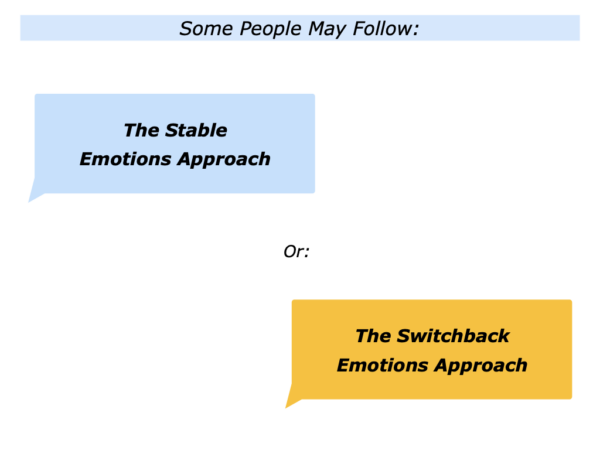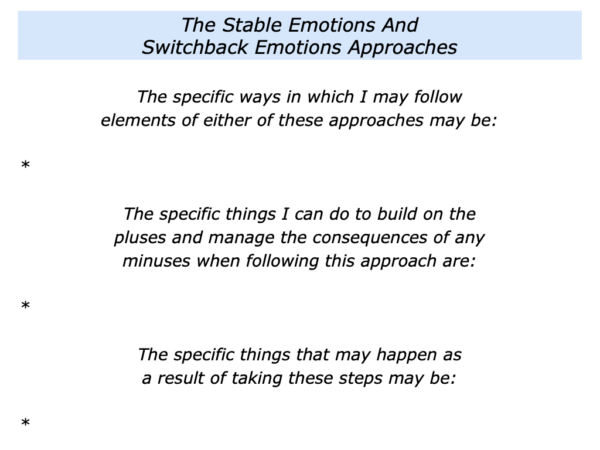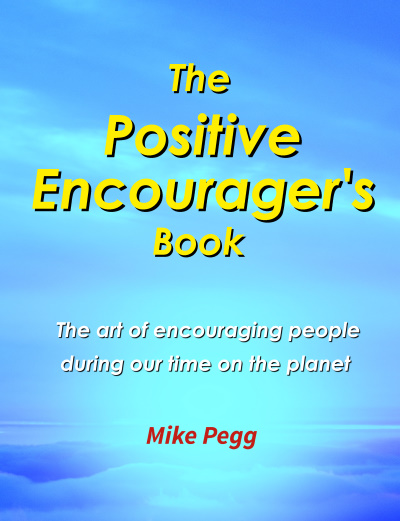
Different people may have different ways of managing or experiencing emotions. Some may have relatively stable emotions. Some may experience a switchback of emotions. Let’s look at these two approaches.
The Stable Emotions Approach
Some people have a relatively steady emotional state. Some may be happy much of the time. One person expressed this in the following way when talking about the 0-10 happiness scale.
“I am virtually always 9+/10. Sometimes I get upset when listening to politicians or watching my football team. But for the most part I am fortunate to positive and happy.”
Some people may be naturally happy most of the time. Alexander Calder, the inventor of the mobile, for example, said that he had the good fortune to be born happy.
Some may have a sense of gratitude. Warren Buffet, the financial sage, says he was fortunate in the ovarian lottery. He was born into a society where it was an advantage to be white, male and have access to education. He explained this in the following way.
“I am lucky. I had the advantage of a home where people talked about interesting things. I had intelligent parents and went to decent schools. I don’t think I could have been raised by a better pair of parents.
“That was enormously important. I didn’t get money from my parents and I really didn’t want it. But I was born at the right time and place. I won the ovarian lottery.”
Some may choose to have a positive attitude. They do things that give them positive energy and spend lots of time with positive people. They may also learn how to manage setbacks successfully.
Such people may also stay positive by focusing on what they can control in situations. They do not go into negative spirals by focusing on what they can’t control.
Some people may experience a different level of stable emotions. Their happiness rating may be consistently low on a scale 0-10. There may be many reasons why this is the case.
A person may have got used to feeling around 6/10 on the happiness scale, for example, and not expect to be happier. When asked how they feel they may answer:
“Not bad considering. Mustn’t grumble.”
Human beings are living systems and often return to a state of stasis. They often do things to maintain their present state of being. Sometimes this means finding positive or negative reasons for maintaining their normal emotional state.
Some people have positive or negative scripts that influence the way they feel. Such people keep repeating these scripts to themselves. This can mean that they keep returning to a certain emotional state.
Some individuals have got used to living in toxic relationship. They may leave one person but move onto a similar relationship. They accept this as the norm and get used to surviving rather than thriving.
The Switchback Emotions Approach
Some people go through a switchback of emotions. Some adrenaline driven people , for example, do this by choice. They love to feel alive, to enjoy drama or to have extreme experiences.
Some highly sensitive people may have a wide range of intensive emotions. They may channel these in a positive way by working as artists, designers, therapists or in other professions.
Some may have more difficulty in managing their emotions. Stephen Fry, the actor, has shared his own experiences with bipolar disorder. Sometimes this can lead to great highs but also deep lows.
During a television programme he described how twenty people with this condition were asked:
“Let me pose a hypothetical question. If you were given the chance to get rid of the lows but, at the same time, lose the highs, what would you do?”
Stephen reported that only one of the twenty people said they would take up this offer. Every person has things they need to manage in life, said Stephen. Bipolar was one such thing for him.
Many websites have been created by people who experience such mood swings. These provide practical tools that people can use to manage this trait. These include the following.
Set and follow a chosen routine … Plan ahead … Do things that give you positive energy … Exercise in way that works for you … Recognise and manage triggers … Learn how to manage your moods … Set and reach achievable goals … Focus on improvement not perfection.
People who demonstrate characteristics of Attention Deficit Hyperactivity Disorder also have strengths. The ADDA website describes these in the following way.
Each individual with ADHD
has unique skills and advantages
Within the ADHD community, these advantages are often referred to as ADHD Superpowers. They are:
Quick Starters … Creative … Adventurous … Courageous … Focused … Intuitive … Detail Oriented … Good In Crises … Entrepreneurial … Driven To Achieve.
Different people develop different ways to build on such traits. Some take the following approach.
They put themselves into places where they can do positive work … They find ways to take a positive role and make a positive contribution … They build on their strengths and do their best to get positive results.
Let’s return to your own life. Can you think of any ways in you may follow elements of the stable or switchback emotions approaches? How can you build on the pluses and manage the consequences of any minuses?
If you wish, try tackling the exercise on this theme. This invites you to complete the following sentences.







Leave a Reply